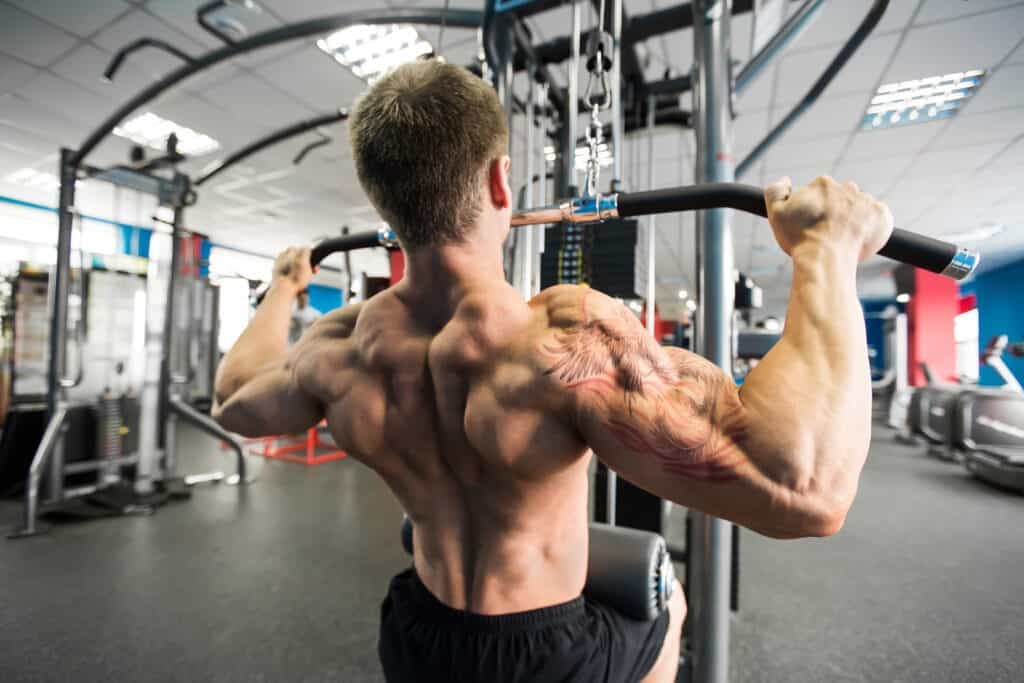One of the more popular exercises used to develop the back is the lat pulldown. Many gym goers seem to like is the versatility of this compound exercise. It is an exercise that offers multiple grip variations. In addition, most gyms typically have 3-4 attachments that you can switch to. Does it make a difference though how you hold these attachments? Let’s take a deeper look and find out.
Hand Grip & Placement in Lat Pulldown
Overhand Grip
The overhand grip is used most often when performing a lat pulldown. In one study, published in the Strength and Conditioning Journal, the lat pulldown was examined for muscle activation. The study showed a pronated, or overhand grip, demonstrated greater muscle activation. The overhand grip was compared to both supinated (underhand grip) and a neutral grip.
Underhand Grip
When you look at this from a biomechanic standpoint, underhand grip does have its benefits. The underhand grip provides a far superior muscle contraction of the lats at the bottom of the movement. You can also handle more weight using an underhand grip compared to an overhand grip. Finally, the closer your hands are positioned on the bar, the more activation you get in the center of your back.
Wide Grip
Many gym goers believe if you use a wider grip you’ll get wider (“thicker”) lats. Placing your hands wider on the lat pulldown bar, decreases the range of motion in the latissimus dorsi. The best bet is to use a diverging movement pattern machine. Wider hand placement means the range of motion at the shoulder increases. Therefore, the lats work through a greater range of motion. See here in this Jefit Instagram post. The wide grip lat pulldown activates significantly more lats and upper back. This is due to the position of the arms (external rotation).
Narrow Grip
Changing the hand placement to narrow (or a close grip) allows more internal rotation of the arms. The narrow grip shifts some of the load away from the lats and puts it on your chest. Even though a wide grip gets a little more activation of the lats, the narrow grip lat pulldown puts your arms in a stronger position, and you can generally pull more weight.
Research Review on the Topic
A 2010 electromyographic study (EMG) study was published in the Journal of Strength & Conditioning Research. The study compared four variations of lat pulldowns. The study used a dozen test subjects who performed all four variations pulling from in front of the head with a predetermined load, about 70 percent of their one repetition max. Muscle response from the latissimus dorsi, middle trapezius and biceps brachii muscle groups were measured during all four lat pulldown variations. The study showed that there was a minor advantage to using a medium grip (i.e. shoulder-width) over narrow and wide grips.
Subsequent Study
A 2009 EMG study looked at the muscular activity difference between a lat pulldown in front of the head versus behind the head as well as a lat pulldown using a ‘V’ bar. The study used 24 test subjects performing five repetitions at 80 percent of their one rep max. EMG data was recorded from the pectoralis major, posterior deltoid and biceps brachii as well as the latissimus dorsi muscle groups. There was no difference in muscular activity for the latissimus dorsi when comparing the three variations. The study, however, concluded when the primary objective of a lat pulldown is considered, the front of the head is a better choice than behind the head due to shoulder safety issues.
For best results, you can’t go wrong changing up both your grip and hand placement every few training sessions.
Try the Jefit App
Jefit is an award-winning gym workout app that helps all gym goers and athletes keep track of their fitness goals. Not only does it give you the ability to update and share your workout log with the supportive community, it has the largest exercise library that covers weight training, cardio and flexibility.
- Boost Your Posterior Strength with 3 Effective Jefit Exercises - March 31, 2025
- 8 Underrated Stretches to Improve Your Deadlift Performance - March 28, 2025
- Strength vs. Hypertrophy: Best Way to Train for Your Goals - March 26, 2025
